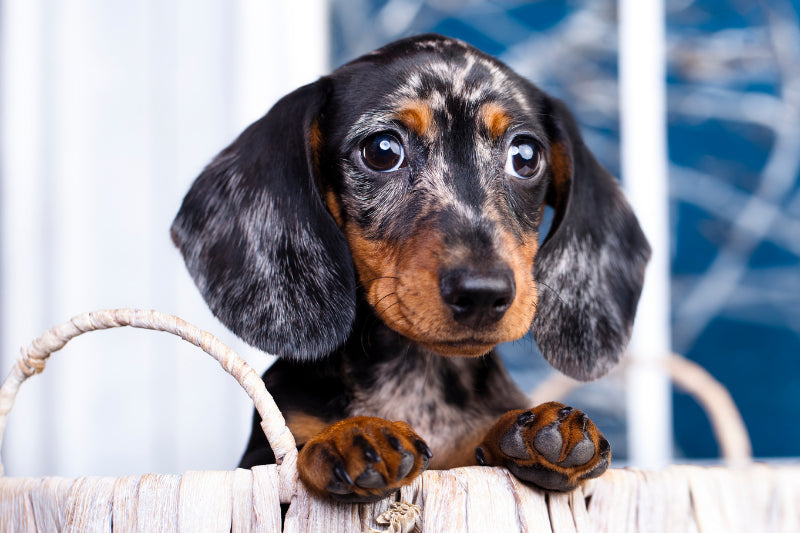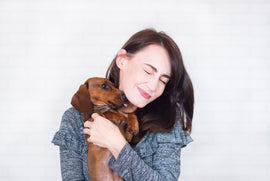Understanding and Addressing Separation Anxiety in Dachshunds
Posted by ROBERTO BURALLI

Understanding Separation Anxiety in Dachshunds
Dachshunds are known for their loyalty and companionship, traits that stem from their history as hunting dogs bred to work closely with humans.
This close bond with their owners can make them particularly susceptible to separation anxiety when left alone.
Additionally, their small size and sensitive nature can exacerbate feelings of vulnerability and anxiety.
Dog experts offer several insights into why dachshunds exhibit these tendencies:
- Breeding History: Dachshunds were originally bred for hunting, which required them to work closely with humans. This history has resulted in a strong attachment to their owners, making them crave companionship and attention.
- Small Size: Dachshunds are small dogs, which can make them feel vulnerable. As a result, they may seek reassurance and security from their owners, leading to clingy behavior.
- Personality Traits: Dachshunds are known for their loyalty and affection towards their owners. They often form strong bonds and may become anxious when separated from them.
- Attention Seekers: Dachshunds require mental stimulation and interaction. When they don't receive enough attention or mental stimulation, they may become clingy as a way to seek out the attention they need.
Symptoms of separation anxiety
Symptoms of separation anxiety in dachshunds can vary in severity but often include:
- Excessive Barking or Howling: Dachshunds may bark or howl excessively when left alone or when they anticipate being left alone. This vocalization is often a sign of distress and anxiety.
- Destructive Behavior: When experiencing separation anxiety, dachshunds may engage in destructive behavior, such as chewing on furniture, doors, or other household items. They may also dig at carpets or scratch at doors in an attempt to escape confinement.
- Pacing: An anxious dachshund may exhibit repetitive pacing patterns, moving back and forth in a particular area of the house. This behavior is often a manifestation of restlessness and anxiety.
- Panting and Drooling: Panting and excessive drooling can occur in dachshunds experiencing separation anxiety. These physical symptoms are signs of stress and discomfort.
- Attempts to Escape Confinement: Dachshunds with separation anxiety may try to escape from their crate, pen, or designated area when left alone. They may become frantic in their attempts to reach their owner or escape the perceived confinement.
- House Soiling: Some dachshunds may urinate or defecate inside the house, even if they are house-trained, when experiencing separation anxiety. This behavior is often a result of stress and anxiety about being left alone.
- Loss of Appetite: A dachshund experiencing severe separation anxiety may exhibit a loss of appetite or reluctance to eat when left alone. This change in eating behavior can be a sign of emotional distress.
- Shadowing Behavior: Dachshunds may exhibit clingy or shadowing behavior, following their owners from room to room and seeking constant reassurance and attention. This behavior is often a coping mechanism for dealing with anxiety when their owners are present.
Dachshund owners need to recognize these symptoms of separation anxiety and address them with appropriate training, management strategies, and, if necessary, professional guidance to help alleviate their dog's distress and improve their overall well-being.

Addressing Separation Anxiety in Dachshunds
Dealing with separation anxiety in dachshunds requires patience, consistency, and a combination of behavioral techniques.
Here are some effective strategies:
- Gradual Desensitization: Gradually accustom your dachshund to being alone by leaving them alone for short periods and gradually increasing the duration over time. Start with just a few minutes and gradually extend the time as your dog becomes more comfortable.
- Establish a Routine: Create a consistent daily routine for your dachshund, including regular feeding times, walks, and play sessions. Predictability can help reduce anxiety by providing a sense of security and structure.
- Provide Distractions: Leave interactive toys, puzzle feeders, or treats for your dachshund to engage with while you're away. These distractions can help keep them occupied and focused on something other than your absence.
- Positive Associations: Associate your departure with positive experiences by giving your dachshund a special treat or toy that they only receive when you leave. This can help create a positive association with your departure.
- Avoid Punishment: It's crucial to avoid punishing your dachshund for their anxious behavior when you return home. Punishment can exacerbate their anxiety and worsen the problem. Instead, focus on positive reinforcement and reward calm behavior.
- Monitor Physical Health: Sometimes, physical health issues can contribute to anxiety in dachshunds. Ensure that your dachshund receives regular veterinary check-ups to rule out any underlying medical conditions that may be causing or exacerbating their anxiety.
- Be Mindful of Triggers: Pay attention to any specific triggers that may worsen your dachshund's anxiety, such as certain sounds or routines associated with your departure. Identifying and addressing these triggers can help mitigate their anxiety.
- Avoid Excessive Reassurance: While it's natural to want to comfort your dachshund when they're anxious, providing excessive reassurance may inadvertently reinforce their anxious behavior. Instead, aim to gradually build their confidence and independence through training and gradual desensitization.
- Consider Professional Help: If your dachshund's separation anxiety persists despite your best efforts, consider seeking guidance from a professional dog trainer or behaviorist. They can provide personalized advice and develop a comprehensive treatment plan tailored to your dachshund's specific needs.
- Patience is Key: Addressing separation anxiety in dachshunds can be a challenging and time-consuming process. It's essential to remain patient, consistent, and persistent in your efforts. With time, dedication, and the right approach, you can help your dachshund overcome their separation anxiety and lead a happier, more balanced life.

Will getting another dog help with separation anxiety?
Adopting a second dog can potentially help alleviate separation anxiety in dachshunds, but it's not a guaranteed solution and requires careful consideration.
Here are some factors to consider:
- Companionship: Introducing a second dog can provide companionship for your dachshund, potentially reducing feelings of loneliness and anxiety when left alone. Having another dog around may offer social interaction and distraction, which can be beneficial for some dachshunds.
- Socialization: A second dog can also help with socialization, especially if your dachshund enjoys the company of other dogs. Interacting with another canine companion can provide opportunities for play, exercise, and mental stimulation, which are essential for overall well-being.
- Compatibility: It's crucial to consider the temperament and compatibility of the second dog with your dachshund. Ideally, choose a dog that has a similar energy level, temperament, and size to your dachshund to ensure a harmonious relationship.
- Training: Introducing a second dog requires proper training and supervision to ensure a smooth transition. Both dogs should be gradually introduced to each other in a neutral environment and supervised closely during initial interactions. Positive reinforcement techniques can help promote bonding and establish positive associations between the dogs.
- Additional Responsibilities: Keep in mind that adopting a second dog means taking on additional responsibilities, including feeding, grooming, training, and veterinary care. Be prepared to invest time, effort, and resources into caring for both dogs properly.
As for breeds that are compatible with dachshunds, it ultimately depends on the individual personalities of the dogs involved. However, breeds that are similar in size, energy level, and temperament to dachshunds may be more compatible. Some potential breeds that could be compatible with dachshunds include:
- Cavalier King Charles Spaniel
- Miniature Schnauzer
- Poodle (Miniature or Toy)
- Shih Tzu
- Bichon Frise
- Maltese
Regardless of the breed, proper introductions, supervision, and training are essential when bringing a second dog into a household with a dachshund. Additionally, consider consulting with a professional dog trainer or behaviorist to ensure successful integration and address any potential challenges that may arise.
Related post: Understanding and Managing Aggression in Dachshunds

Conclusion
Separation anxiety in dachshunds can be a challenging issue to address, but with patience, understanding, and consistent training, it can be managed effectively. By employing strategies such as gradual desensitization, establishing a routine, providing distractions, considering the adoption of a second dog, and seeking professional help when needed, dachshund owners can help their beloved pets feel more comfortable and confident when left alone, leading to a happier and healthier relationship between dog and owner.
SHARE:












